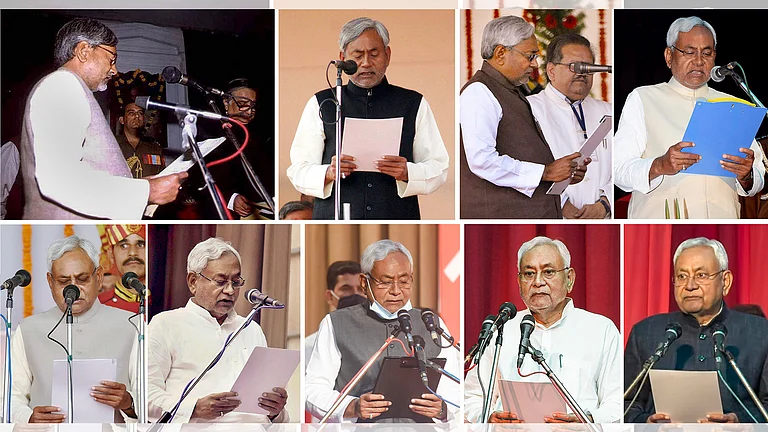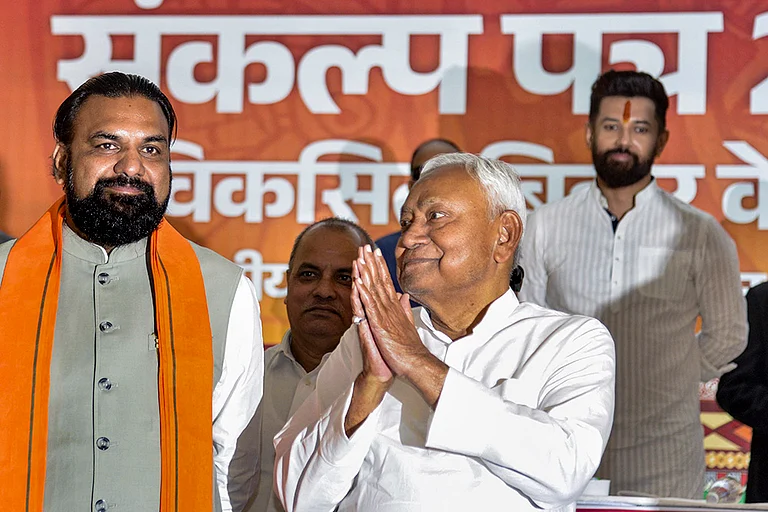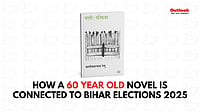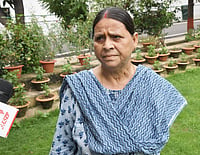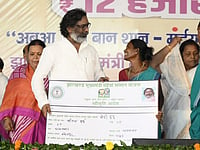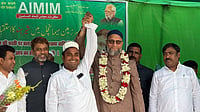Around 4 pm on November 14, as the BJP comes close to bagging 90 seats and the alliance it leads, the National Democratic Alliance (NDA), surges past the 200-seat mark in the 243-seat Bihar Assembly, the mood among workers at the party’s Patna office is upbeat. “Soon we’ll have a BJP chief minister,” some say. “No, Nitish (Kumar) ‘chacha’ will remain CM. Else, the whole game will collapse,” retorts Mahesh Das, a staunch BJP supporter from Bihta town 55 km away, as he walks out of the room.
“At 50, I have seen enough political ups and downs. And understanding Nitish in Bihar isn’t everyone’s cup of tea,” Das says. “If the BJP tries to install its own CM, everything will fall apart. ‘Chacha–bhatija’ (Nitish and Tejashwi Yadav) will join hands and form the government. Nitish ji is an engineer by degree and by temperament. This mandate is for his development model.”
Das does not believe the chatter around Nitish’s declining health. “He is mentally sharp and resilient,” he says. Those who have worked closely with Nitish often say he would stay with the BJP, but only on his own terms. Some argue Nitish has stood like a wall for nearly 25 years between the BJP and its ambition to build a strong Hindutva-oriented backward-caste leadership in Bihar. He ensured the BJP remained dependent on his party, the Janata Dal (United). When the late Sushil Modi was deputy chief minister in Nitish’s government, many believed he was more loyal to Nitish than to his party, the BJP.
As the results became clearer on November 14, JD(U) workers began chanting slogans about Nitish—among them, “Tiger abhi zinda hai (Tiger is alive)” and “Nitish zaroori bhi hain, majboori bhi (Nitish is indispensable)”, both subtle responses to questions about Nitish’s health. Both the Rashtriya Janata Dal (RJD) and the Congress have attacked the BJP for projecting Nitish as CM despite raising questions about his fitness. The BJP has been saying the alliance is contesting the election under Nitish’s leadership, without stating whether he would remain CM after victory.
“Nitish will be our leader and CM,” Union minister Jitan Ram Manjhi said after an NDA meeting in Delhi on November 17. His party—the NDA ally Hindustani Awam Morcha (Secular), or HAM-S, which bagged five seats—has repeatedly insisted, “Nitish was, is and will remain CM.”
In 2020, when the BJP emerged as the largest NDA party with 74 seats and the JD(U) bagged only 43, Nitish was seen as a strong politician. When Nitish offered the BJP the CM’s post, the BJP declined, wary he could switch to the Mahagathbandhan. Two years later, Nitish dumped the BJP and returned to the RJD–Congress alliance.
The NDA victory was like a silent storm that India’s 21st-century “political weather department” couldn’t predict. The biggest factor behind Nitish and the NDA’s victory was women’s support.
Today, the circumstances are different. Back then, the opposition Mahagathbandhan (Grand Alliance or INDIA bloc) had 110 seats. Today, it has collapsed to 35, including RJD 25, Congress six and the Left parties, three (despite a marginal rise in their votes). With a doubled tally—85, four short of the BJP—Nitish’s options outside the NDA have shrunk, making him weaker. The Asaduddin Owaisi-led AIMIM won five seats. The NDA bagged 46.5 per cent of the votes polled, winning in 202 constituencies. The Lok Janshakti Party (Ram Vilas), or LJP (RV), won 19 seats, and the Rashtriya Lok Morcha (RLM) led by former JD(U) leader Upendra Khushwaha, four.
“If Nitish tries to engineer a non-BJP coalition, the JD(U)’s ‘upper’-caste MLAs may defect to the BJP,” says analyst Prem Kumar Mani, who has known both Lalu Prasad and Nitish closely. “Going back to the RJD isn’t easy. In five years, the BJP will push for its own CM. A few MLAs may scatter, but most will join the BJP as there is no leader of socialist appeal left in Nitish’s party. Eventually, the BJP will absorb his party.”
According to Mani, capturing Bihar has long been one of the BJP’s biggest goals, and this is the closest they have ever been. He also believes Nitish’s health has declined, making a full term as CM unlikely. For the first time in 20 years, Nitish did not address the media after election results. “Though Nitish held nearly 100 rallies this time, if he were the old Nitish, he would have held a presser. He always has,” says NDTV managing editor Manoranjan Bharti ‘Baba’, who has covered Bihar politics for three decades. “The question isn’t whether he will become CM again, but how long will he stay in office.”
According to Bharti, the JD(U)’s survival depends on Nitish’s continued relevance. “The JD(U), essentially an OBC party, today has two factions, with people saying the ‘upper’ castes dominate it. Can Nitish manage this? The mandate is there, but can he sustain it?” he asks. “The BJP has more seats and wants to be the engine now. It will attempt a ‘change of guard’ only once it feels confident running the Centre without Nitish’s support. The day they figure that out, the game in Bihar will change.”
Professor Rakesh Ranjan of Patna University recalls the period when Nitish briefly joined the INDIA bloc before the Lok Sabha election. “Nitish was being invited to contest from Uttar Pradesh, too, due to his influence among certain backward-caste pockets there. Had the Congress accommodated him, the NDA might have suffered even more. That’s why the BJP won’t risk removing him now. With elections ahead in West Bengal and UP, sidelining Nitish would send the wrong message and give the Opposition a caste narrative to exploit.”
Admitting that Nitish’s bargaining power is weaker this time, Ranjan says, “The BJP will claim key portfolios, especially Home, which Nitish always kept.”
The 2025 Bihar mandate has once again reaffirmed Nitish Kumar’s centrality to the state’s politics. Yet, this victory also marks the beginning of a more complex phase for him.
Having been Bihar’s CM continuously since 2005, Nitish resigned in 2014 after the Lok Sabha debacle, making Jitan Ram CM, but returned to the post within months. In 2015, he broke with the BJP to ally with the RJD and the Congress. After two and a half years, he switched back. In 2022, he left the BJP for the RJD, only to return 17 months later. Wherever he went, though, he held on to the CM’s chair and key ministries. Despite two and a half decades in power, there was no visible anti-incumbency against him this time.
The NDA victory was like a silent storm that India’s 21st-century “political weather department” couldn’t predict. The biggest factor behind Nitish and the NDA’s victory was women’s consistent support. The CM’s Women Employment Scheme, announced just before the election, transferred Rs 10,000 to nearly 1.41 crore women in six weeks—shifting the entire electoral equation. Women voted beyond caste lines. Bihar recorded its highest turnout (66.9 per cent) since 1951, with 71 per cent of the female electorate casting their votes—8.2 percentage points above men (62.8 per cent).
Since 2005, women have outvoted men in Bihar, a shift attributed largely to Nitish’s women-focused governance: 50 per cent reservation in panchayats, cycles and scholarships for girls, prohibition, self-help groups (SHGs), 35 per cent job reservation, and now large-scale direct transfer schemes. These built a loyal base of women across castes.
Another key factor was the disarray in the Mahagathbandhan, while the NDA’s stable social coalition—non-Yadav OBCs, extremely backward classes (EBCs), economically weaker sections (EWS) and some Dalit communities—together with the Centre’s welfare programmes proved decisive. If anyone deserves the primary credit for the NDA’s landslide, it’s Nitish, say experts. Who will inherit his political legacy remains unanswered. Speculation naturally leads to his son, Nishant. Before the polls, his name surfaced repeatedly, though Nitish has always opposed dynastic politics. Nishant tells the media that his father is healthy and will remain CM. After the results, a photo of Nishant hugging Nitish went viral, and Purnia MP Rajesh Ranjan, also known as Pappu Yadav, even suggested he should be made CM after Nitish.
“Leadership transition has always been an issue for India’s regional parties, and they usually bring in second-generation leaders from within the family,” says Professor Ranjan. “If they don’t, the party collapses. Look at the DMK (survived with Stalin) and its rival AIADMK (no stabilising successor).”
The old guard, mainly from backward castes, wants Nishant to take charge, fearing the party might fall apart otherwise, opines Professor Ranjan. “The other camp won’t oppose him openly but prefers the status quo. Still, I don’t think Nitish will rush to project Nishant,” he says.
On whether socialism will decline in Bihar after Nitish, D.M. Diwakar, former director of the A.N. Sinha Institute in Patna, disagrees. “Nitish and Lalu were products of Bihar’s socialist soil, not the other way around. Bihar will produce another socialist leader when needed,” he says.
The 2025 Bihar mandate has once again reaffirmed Nitish Kumar’s centrality to the state’s politics. Yet, this victory also marks the beginning of a more complex phase for him, with shrinking alternatives outside the NDA and a strengthened BJP eager to expand its influence. While his leadership remains indispensable for now, questions about longevity, succession and power-sharing will shape Bihar’s political landscape in the coming years. Ultimately, the stability of both the JD(U) and the NDA may depend on how long Nitish can continue balancing equations that only he has mastered for two decades.
MORE FROM THIS ISSUE
Md Asghar Khan is senior correspondent from Jharkhand.









